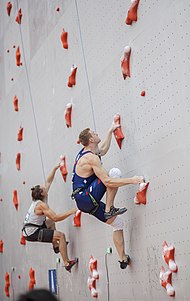| Part of a series on |
| Climbing |
|---|
 |
| Lists |
| Types of rock climbing |
| Types of mountaineering |
| Other types |
| Key actions |
| Key terms |
Speed climbing is a climbing discipline in which speed is the ultimate goal.[1] Speed climbing is done on rocks, walls and poles and is only recommended for highly skilled and experienced climbers.[2]
Competition speed climbing, which takes place on an artificial and standardized climbing wall, is the main form of speed climbing. However, there are types of speed climbing that take place outdoors, such as climbing famous big wall climbing routes in the shortest times, notable examples being on El Capitan in Yosemite National Park.
Competition speed climbing as governed by the International Federation of Sport Climbing (IFSC) takes place on 15-metre (49 ft) artificial walls. Competitors climb a 5-degree overhanging IFSC-certified wall, with an auto-belaying system from the top of the wall.[3]
Since 2007 the IFSC has created a standard wall for the world record. The standard has a simple rule and it involves climbers competing on the same route, side by side, and whoever reaches the top first wins.[4] The holds and order are always identical, and the difficulty rating is around F6b (approximately YDS 5.10c), which is a level most recreational climbers could complete. The IFSC also sanctions speed climbing competitions[5] and those events that entail world record attempts.[6] Speed climbing was one of the three climbing modalities included in the combined format at the 2020 Olympic Games in Tokyo, along with lead and bouldering. Beginning at the 2024 Summer Olympics in Paris, speed climbing will be its own standalone competition, separate from the lead and bouldering combined event.[7]
Time is determined by mechanical-electric timing (the competitor leaves the starting pad and strikes a switch at the top of the route). When mechanical-electric timing is used, the climbing time is displayed with an accuracy of one-hundredth of a second. In the rules modifications in 2018, the possibility to use manual timing was removed, and the mechanical-electric timing should record with a precision of 1/1000 second. This precision is only used for ranking in case of a tie. Further, the timing system needs to announce a false start, which is considered a start earlier than 0.1 seconds after the starting beep.[8]
The defending men's and women's speed climbing world champions are Matteo Zurloni of Italy and Desak Made Rita Kusuma Dewi of Indonesia, respectively; they won their respective speed events at the 2023 IFSC Climbing World Championships in Bern, Switzerland.[9] Veddriq Leonardo of Indonesia and Natalia Kalucka of Poland were the overall men's and women's winners for the 2023 IFSC Climbing World Cup speed series.[10] [11]
Since Qixin Zhong of China ran the 15-meter standardized wall in 6.26 seconds in 2011, the world record has been broken 15 times, ten times since 2021, most recently 4.798 seconds by Samuel Watson of USA in April 2024 at the Wujiang World Cup. That represents a drop of 23 percent since 2011.
Similarly, the women's speed climbing record has been broken 18 times since 2013, seven times since 2021, dropping from 7.85 seconds to the 6.25 seconds set by Aleksandra Mirosław of Poland in April 2023, a 20-percent reduction.[12]
| Date | Time (s) | Person | Location | Competition |
|---|---|---|---|---|
| April 12, 2024 | 4.798[13] | Wujiang, China | World Cup | |
| April 12, 2024 | 4.859[14] | Wujiang, China | World Cup | |
| April 28, 2023 | 4.90[15] | Seoul, South Korea | World Cup | |
| April 28, 2023 | 4.984[16] | Seoul, South Korea | World Cup | |
| July 8, 2022 | 5.009[17] | Chamonix, France | World Cup | |
| June 30, 2022 | 5.04[18] | Villars, Switzerland | World Cup | |
| June 30, 2022 | 5.09[19] | Villars, Switzerland | World Cup | |
| May 27, 2022 | 5.10[20][21] | Salt Lake City, US | World Cup | |
| May 6, 2022 | 5.17[22] | Seoul, South Korea | World Cup | |
| May 28, 2021 | 5.20[23] | Salt Lake City, US | World Cup | |
| May 28, 2021 | 5.25[24] | Salt Lake City, US | World Cup | |
| April 30, 2017 | 5.48[25] | Nanjing, China | World Cup | |
| September 12, 2014 | 5.60[26] | Gijon, Spain | World Championships | |
| August 31, 2014 | 5.73[27] | Arco, Italy | World Cup | |
| August 30, 2014 | 5.76[28] | Arco, Italy | World Cup | |
| October 13, 2012 | 5.88[29] | Xining, China | World Cup | |
| August 27, 2011 | 6.26[30] | Arco, Italy | World Championships |
| Date | Time (s) | Person | Location | Games |
|---|---|---|---|---|
| August 3, 2021 | 5.45[31] | Aomi Urban Sports Park, Tokyo, Japan | Tokyo 2020 |
| Date | Time (s) | Person | Location | Games |
|---|---|---|---|---|
| August 6, 2021 | 6.84[54] | Tokyo, Japan | Tokyo 2020 | |
| August 4, 2021 | 6.97[55] | Tokyo, Japan | Tokyo 2020 |
Most non-competition speed climbing records lack the standards normally associated with objective records. Competition speed climber Hans Florine has written about non-competition speed climbing: "I will be the first to say that climbing is silly. To make rules about it is just piling ridiculous on top of silly."[56]
However, various climbers have set "speed records" on well-known and frequently climbed routes, such as Dan Osman climbing Lover's Leap via the Bear's Reach route (5.7, 120+ metre) in 4 min 25 sec.[57] The most notable of such records are listed below:
Regular Northwest Route, Half Dome
Snake Dike, Half Dome